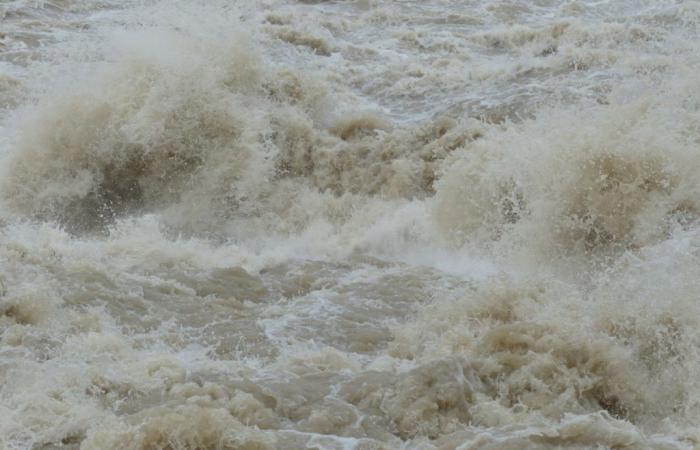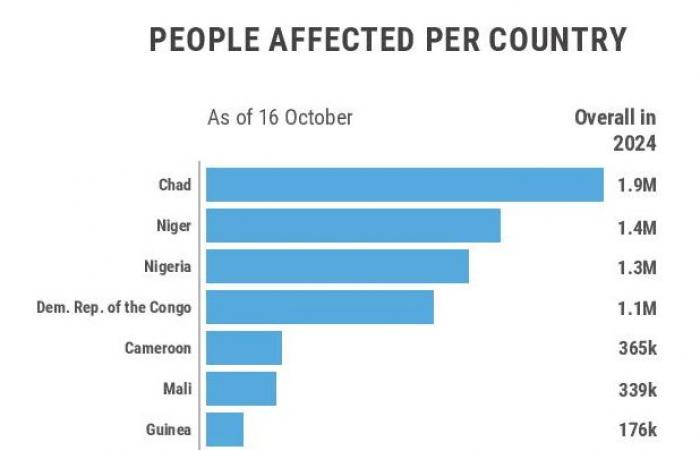Ouestafnews – Since the start of 2024, deadly floods have hit several countries in West and Central Africa, affecting several million people, according to international humanitarian agencies and the authorities of certain states concerned. Ouestaf News returns to the situation in West Africa.
“For several months, the countries of West and Central Africa have been experiencing unprecedented floods, which have destroyed homes, devastated crops, washed away livestock and led to loss of human life,” notes the International Federation of Red Cross and Red Crescent Societies (IFRC) in an article published on November 6, 2024.
Ouestaf News was unable to have a separate report for all West African countries.
“Although rainfall is decreasing in the West and Central Africa region, it continues to cause damage and affect new populations. In total, 7.1 million people have been affected since the start of 2024,” reports the UN Office for the Coordination of Humanitarian Affairs (Ocha) in an infographic posted online on November 4 2024.
According to Ocha, floods have caused the deaths of more than 1,500 people since the start of 2024 in these two geographic regions in Africa. They have also pushed more than a million people in eleven countries to become “internally displaced,” that is, people who have left their homes to seek refuge elsewhere within their borders.
The majority of these internally displaced people (729,000) were recorded in Nigeria, according to the same UN agency. Ocha reported, on the date of 1is November 2024, of “more than 320 deaths and 1.3 million people affected by floods in 34 states” in the English-speaking federal country of West Africa.
Torrential rains and disarray
“The water level is so high this year! And every day it gets worse! », Testified one of the displaced Nigerians, Mamat Ibrahim, on Radio France Internationale (RFI) in Hausa language on October 15, 2024. Ms. Ibrahim is from Kogi State, in central Nigeria. She took refuge with relatives, distraught, according to her story to RFI: “In my village, there are between 22 and 25 houses: all were destroyed and all the crops were taken away. Vegetables, herbs, rice, corn: everything! “.
In September 2024, torrential rains caused the Alau dam to burst, causing flooding in northeastern Nigeria, especially in Maiduguri, capital of Borno state, according to testimonies from locals and humanitarian organizations. and international media. Maiduguri “is facing its worst floods in 30 years after the Alau dam burst,” wrote the Nigeria office of the United Nations High Commissioner for Refugees (UNHCR) on September 10, 2024 on the X platform (formerly Twitter).
There was also great dismay in Niger, a Sahelian country suffered by years of struggle against armed Islamist groups and various criminal gangs. “Some regions recorded “up to 200%” excess rain compared to previous years,” reported the French newspaper Le Monde on October 28, 2024, citing Nigerien meteorological services.
The Nigerien authorities claimed to have recorded more than 1.5 million flood victims, according to a report as of 1is November 2024 reported by the Nigerien Press Agency (ANP, official), which does not mention the number of deaths. According to Ocha, bad weather has caused 391 deaths in Niger since June 2024.
Along with Chad and the Democratic Republic of Congo, located in Central Africa, Niger and Nigeria also top a list established by Ocha of sixteen countries according to the number of people affected by these disasters in West Africa. Center. The other West African countries on this list dating from October 29, 2024 are Mali, Guinea, Togo, Benin as well as, at the very end of the ranking, Gambia and Sierra Leone.
The torrential rains have worsened the situation for thousands of residents of Mali, already in the grip of a complex security, economic and social crisis marked by a war against armed groups, soaring food prices and tense diplomatic relations with neighbors, regional organizations or former leading partners.
“Since July 2024, these floods have caused 92 deaths, 154 injured, and nearly 380,000 people affected in the country”, where tens of thousands of buildings and fields have been destroyed, according to an Ocha report. as of October 29, 2024. These figures are contained in a situation update published by Ocha on November 5, 2024.
Faced with the seriousness of the situation, the Malian authorities declared a “state of national disaster” in August 2024. One of the consequences of the floods was the postponement of the 2024-2025 school year: initially scheduled for 1is October 2024, it was carried out on November 4.
The army to the rescue
Senegal, neighboring Mali, has also recorded tragedies due to flooding. It was hit in October 2024 by the flooding of the Senegal River, affecting regions in the north, east and southeast of the country. “According to official government figures, more than 55,600 people spread across 51 villages and 44 other sites were affected by the rising Senegal River. More than 1,000 hectares of crops were damaged” in four regions, Ocha reported on October 22, 2024. The Senegalese state mobilized the army for relief operations in the disaster areas, in particular “to evacuate villagers and the livestock in areas along the Senegal River.
In Guinea, several regions were seriously affected by floods in August and September 2024. According to a report published on October 21, 2024 by the National Agency for Emergency and Humanitarian Disaster Management (Anguch) of Guinea and its partners, the overflows floods caused the death of five people and more than 1,000 were injured on 1is October 2024. In addition, according to the same count, “more than 175,000 people were severely affected by this natural disaster” in 18 of the country’s 33 prefectures.
The reduction in rain intensity or the end of precipitation, depending on the country, does not, however, mean the end of problems in the affected regions, humanitarian actors have warned.
“Overall, the number of people affected and the impact on agricultural production, and therefore on the food and nutritional security of vulnerable communities, are much greater than in previous years,” Ocha warned on November 4, 2024.
The Famine Early Warning Systems Network (Fews Net) is already considering “decreases in cereal production” in certain countries between 2024 and 2025 due to the impact “widespread flooding” which occurred from July to October 2024, and which impacted “cultivated land in the Sahel”. Among the countries affected by these reductions in harvests “at this stage” are “Burkina Faso, Cape Verde, Mauritania, Nigeria and Sierra Leone”, indicates Fews Net in a report published on November 8, 2024. This network was created in 1985 at the initiative of the American Agency for International Development (USAID).
hd/cs/ts
You want to react to this article or notify us of an error, send us an email to info[@]ouestaf.com







